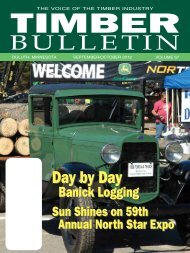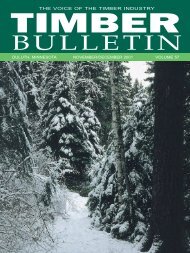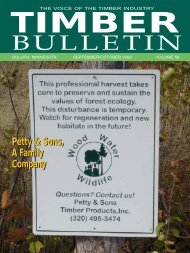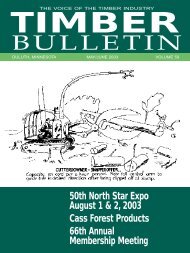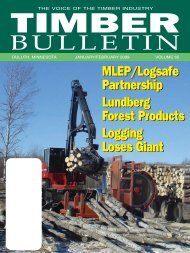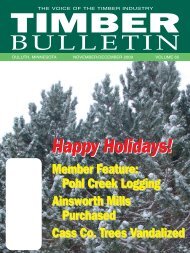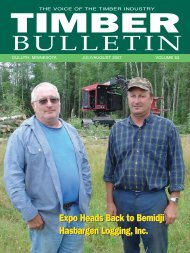Timber Bulletin Nov/Dec - Minnesota Forest Industries
Timber Bulletin Nov/Dec - Minnesota Forest Industries
Timber Bulletin Nov/Dec - Minnesota Forest Industries
You also want an ePaper? Increase the reach of your titles
YUMPU automatically turns print PDFs into web optimized ePapers that Google loves.
With the winter logging<br />
season starting out with a lot of<br />
cold weather it is encouraging to<br />
see our roads and landings<br />
freezing up much better than in<br />
the past several years. This time<br />
of year there is a lot of work to<br />
be done with the mills’<br />
inventories quite low. I hope an<br />
early freeze-up can mean a safer<br />
logging season with ample time<br />
to get the wood out.<br />
President’s<br />
Column<br />
This<br />
year the<br />
fall board<br />
of<br />
directors<br />
meeting<br />
was moved up<br />
five or six weeks<br />
and seemed to<br />
be more<br />
favorable<br />
because of a less<br />
busy time of<br />
year. Issues at that meeting of<br />
high importance were timber<br />
availability and transportation<br />
concerns. Because of the budget<br />
shortfall in <strong>Minnesota</strong>, the DNR<br />
is having a hard time coming up<br />
with enough money to put up its<br />
planned timber sale volume. I<br />
find it hard to believe they<br />
would cut a program that makes<br />
the state a good profit each year.<br />
When funds are low they should<br />
be selling more timber in my<br />
way of thinking. This also holds<br />
true for the counties.<br />
Jim Sanders, the supervisor of<br />
the Superior National <strong>Forest</strong>,<br />
gave a report of activities on the<br />
national forest. We are all<br />
hoping for improvement on the<br />
two national forests. I do believe<br />
we will see some changes for the<br />
better in time to come.<br />
Let’s all work towards a<br />
profitable and safe winter.<br />
Two More of <strong>Minnesota</strong>’s “Best”<br />
Germaine and Jeanne Davison<br />
by Kathleen Preece<br />
It’s difficult to pick out the<br />
driveway to one particular tree<br />
farm in <strong>Minnesota</strong>, and state that<br />
”this leads to the best tree farm in<br />
the state.” There are so many<br />
driveways, and so many incredibly<br />
wonderful tree farms.<br />
And, you know, there are a lot of<br />
not so incredibly wonderful tree<br />
farms. But the commitment to, and<br />
interest in by their respective title<br />
holders IS exemplary. And we<br />
honor all of you.<br />
As is tradition, each year one tree<br />
farmer is singled out as<br />
<strong>Minnesota</strong>’s Tree Farmer of the<br />
Year. This tree farm exemplifies<br />
good land stewardship and<br />
commitment to sustainable forestry.<br />
But more importantly, this tree<br />
farmer serves as representative to<br />
all of you who do just that – good<br />
land stewardship and commitment<br />
to sustainable forestry.<br />
In 2002, we tout Germaine and<br />
Jeanne Davison of Hokah, Minn.,<br />
located in <strong>Minnesota</strong>’s southeastern<br />
Bluff Country. The Davisons also<br />
own land in Wisconsin.<br />
Germaine purchased this farm in<br />
1969. The tree farm was certified in<br />
1980. Germaine and Jeanne have<br />
actively managed the woods since<br />
that time. Management plans have<br />
been prepared and followed; the<br />
most recent plan was updated in<br />
the early 1990s. Over the years<br />
Germaine has followed the<br />
management advice of his service<br />
forester and has been willing to try<br />
new practices for improved<br />
woodland stewardship. A few of<br />
the practices the Davisons have<br />
undertaken include:<br />
• Regeneration: 1970-one acre;<br />
1979-two acres; 1980-five acres<br />
1987-three acres.<br />
• 1988-an alternate row planting of<br />
white pine and red oak was tried<br />
on 10 acres. Oaks did poorly; the<br />
pines have been very successful.<br />
Oaks were coppiced in 2000 to<br />
try to improve the form of the<br />
trees because of destruction from<br />
deer predation in prior years.<br />
• Direct hardwood seeding during<br />
the fall of 2000 on four acres.<br />
One of the first to take place in<br />
southern <strong>Minnesota</strong>.<br />
• 2002: three acres tree planting on<br />
a Conservation Reserve Program<br />
field.<br />
• <strong>Timber</strong> Stand Improvement<br />
(TSI): 1980-28 acres.<br />
• 1992: site preparation for natural<br />
regeneration.<br />
• 1992: 5,800 feet of woods road<br />
improvement; waterbars<br />
installed and roads reseeded.<br />
• 1998: 28 acres TSI thinning and<br />
weed tree removal.<br />
• 1999-23 acres TSI and pruning of<br />
13-year-old black walnut planting.<br />
• Harvest activity: 1992-17acres<br />
harvest of sawlogs and veneer.<br />
• 1997: 30 acres sawlogs and veneer.<br />
The Davisons are active in their<br />
community. Besides farming,<br />
Germaine worked as an extension<br />
educator for many years. They<br />
have gone to the effort and expense<br />
to attend six National Tree Farm<br />
conventions throughout the nation<br />
and comment: “The national<br />
conventions are very useful learning<br />
tools; besides, it is just fun too be<br />
around like-minded tree farmers.”<br />
Mark your calendars for the 2003<br />
North Star Expo<br />
August 1 & 2<br />
St. Louis County Fairgrounds<br />
Proctor, <strong>Minnesota</strong><br />
4<br />
<strong>Timber</strong> <strong>Bulletin</strong> <strong>Nov</strong>ember/<strong>Dec</strong>ember 2002



